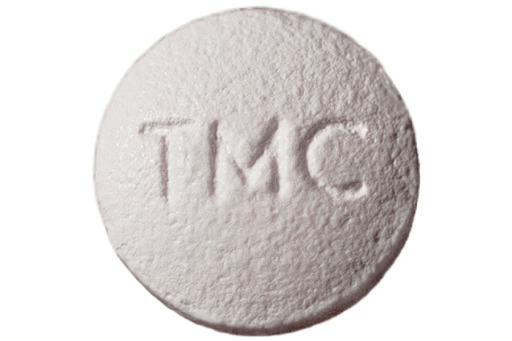Edurant
25 mg rilpivirine RPV (NNRTI)

Standard Dose
One tablet, once daily with a standard meal. For adults and children (12 years of age and older weighing at least 77 pounds, or 35 kg) taking HIV treatment for the first time (treatment-naïve) with viral load less than 100,000. Must be taken in combination with another antiretroviral(s) from a different drug class. No dose adjustment needed for pregnant people with undetectable viral load on a stable rilpivirine-based regimen, but monitor viral load closely because lower rilpivirine drug exposure has been observed during pregnancy.A long-acting injectable form is available; see Cabenuva page.
According to HHS guidelines, viral load (HIV RNA) should be less than 100,000 copies/mL and CD4 T cell count must be above 200 cells/mm3 before starting Edurant due to higher rates of virologic failure in people who don't meet these levels. The CD4 requirement, however, is no longer on the drug label.
Take missed dose as soon as possible with a meal, unless it is closer to the time of your next dose. Do not double up on your next dose.
Must be taken with a meal that you chew—not just a nutritional drink or a protein shake, or a light snack. Taking rilpivirine without food could result in up to a 40% decrease in drug absorption and may lead to resistance.
• See package insert for more complete information on potential side effects and interactions.
Manufacturer
Janssen Therapeuticsedurant.com
(800) JANSSEN (526-7736)
AWP
$1,620.26/monthPotential Side Effects and Toxicity
Edurant is a very tolerable medication. Moderate to severe side effects are uncommon. Most common side effects occurring in 3–5% of study subjects were insomnia, headache, rash, and depressive disorders. Stop taking Edurant and see a medical provider right away if allergic reaction or rash occurs with any of the following: fever, trouble breathing or swallowing, blisters, mouth sores, redness or swelling of the eyes, or swelling of the face, lips, mouth, tongue, or throat. Tell your doctor right away if you experience feelings of sadness, hopelessness, anxiety or restlessness, or have suicidal thoughts or actions. A small study showed a higher rate of depressive disorders in adolescents (19.4%—seven out of 36 youths—vs. 9% for adults), which may or may not have been related to Edurant. Edurant also has minimal negative effects on LDL (“bad”) cholesterol, total cholesterol, and triglycerides compared to Sustiva. Edurant improved HDL (“good”) cholesterol slightly less than Sustiva. Liver problems can occur, but are very rare. The risk may be greater for people with a history of hepatitis B or C, but may occur in people without a history of liver disease. Edurant can cause an increase in kidney function test (serum creatinine) within the first four weeks of treatment. The changes are not considered clinically relevant.
Potential Drug Interactions
Edurant cannot be taken with the antiseizure medications carbamazepine, oxcarbazepine, phenobarbital, or phenytoin; the anti-TB drugs rifampin and rifapentine; proton pump inhibitors (Aciphex, Dexilant, Nexium, Prevacid, Protonix, and Prilosec); or St. John’s wort. Do not take with more than one dose of the injectable steroid dexamethasone (sometimes given in the ER or hospital). Antacids or other products containing aluminum, calcium carbonate, or magnesium hydroxide should be taken two hours before or at least four hours after Edurant. Acid-reducing drugs (Pepcid, Tagamet, Zantac, and Axid) should be taken 12 hours before or four hours after an Edurant dose. If administered with rifabutin, the dose of Edurant should be increased to two 25 mg tablets once daily with a meal. When rifabutin is stopped, Edurant dose should be decreased to 25 mg daily. Monitor for worsening of any fungal infections when Edurant is used with antifungal medications such as fluconazole, itraconazole, ketoconazole, posaconazole, and voriconazole; dose adjustment for these medications may be needed. Use azithromycin when possible instead of clarithromycin, erythromycin, and telithromycin. Methadone levels are reduced slightly and people should be monitored for symptoms of withdrawal. Edurant should be used with caution when taken with other medications with a known risk for torsades de pointes or QT prolongation (these abnormal heart rhythms can make the heart stop).
More Information
Rilpivirine combined with dolutegravir was approved by the FDA in late 2017; see Juluca. A long-acting injectable formulation of rilpivirine was approved in 2021 along with a long-acting injectable formulation of cabotegravir to form a complete regimen given once a month or once every two months; see Cabenuva. This regimen is approved to replace oral ART in patients with virologic suppression and no history of resistance to RPV or INSTIs. Edurant is not DHHS recommended for treatment-naïve people with a pre-treatment viral load greater than 100,000 copies/mL and CD4 T cell count below 200 cells/mm3. The CD4 requirement, however, is no longer on the drug label. A rilpivirine-based regimen may be advantageous for people with high risk for heart disease due to its relatively low impact on lipid profile. The clinical benefit of these findings has not been demonstrated. While its tolerability and safety profiles are advantages for Edurant, the greater potential for virologic failure in people with high viral loads, food restrictions, and cross-resistance to the other NNRTIs puts Edurant at a disadvantage for first-time treatment—people may not be able to switch to another NNRTI if their HIV develops NNRTI-resistant mutations to Edurant. Data for use of rilpivirine in combination with an abacavir/lamivudine background are insufficient to recommend at this time. For individuals with HIV-2, commonly found in some other countries, an NNRTI would not be recommended as HIV-2 is inherently resistant to NNRTIs. Edurant can be used during pregnancy, and is listed as a DHHS alternative NNRTI to use during pregnancy in combination with a two-NRTI backbone. According to the FDA, lower exposures of rilpivirine were observed during pregnancy; therefore, viral load should be monitored closely. Pregnant individuals can voluntarily enroll in the Antiretroviral Pregnancy Registry through their provider;
GO TO apregistry.com.
Doctor Comments
Dr. Melanie Thompson:
Oral rilpivirine is primarily used as a component of the STRs Odefsey, Complera and Juluca. It should only be initiated when viral load is below 100,000 copies/mL and CD4 is at least 200 cells/mL and should be taken with a meal of at least 390 calories. Rilpivirine can be associated with depression or headache, liver toxicity (especially in people with hepatitis B or C), rash (including a severe hypersensitivity reaction) and increased risk of kidney stones or gallstones. There are many important drug-drug interactions with oral rilpivirine. It requires acid for absorption and should not be taken with antacids, acid blockers or proton-pump inhibitors such as Prilosec, Pepcid or Nexium. It can lower the levels of other drugs, such as methadone, and rilpivirine levels are decreased by some seizure and tuberculosis medicines, dexamethasone and St. John’s wort. There are other drug interactions, so it’s a good idea to discuss any drugs you take, including over-the-counter meds and supplements, with your HIV care provider. A long-acting injectable formulation of rilpivirine is paired with injectable cabotegravir as Cabenuva. Drug interactions for the injectable formulation differ from those of the oral drug.
Activist Comments
Activist Joey Wynn:
Edurant is a once-daily pill that must be taken with food. Edurant has lots of drug-drug interactions. Given other available options, Edurant is not an obvious choice for most people; there are just too many easier to take regimens available now. #HardPass.


